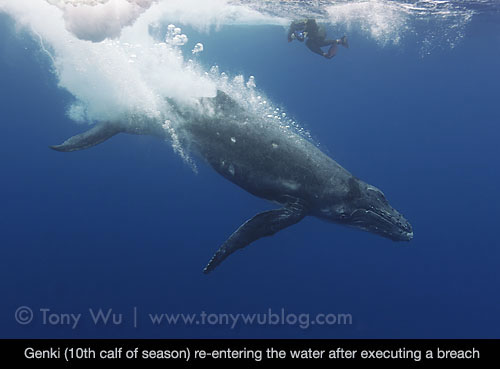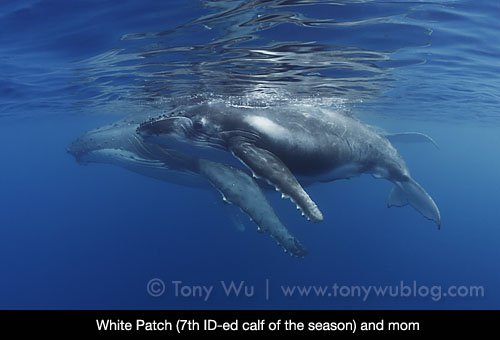If my second week in Tonga this season was busy, my third one was as hectic as rush hour at Tokyo Station, both in the water and on land.
In the water, I finally(!) got to see a heat run this season, an experience that was punctuated by the an unusual sound from one of the five whales involved; our ID-ed calf count grew to 12 from six; one of the calfs we met was perhaps the most active one I've ever seen; I managed to get a couple spending their honeymoon with us into the water with a singer for a honeymoon serenade; and besides whales, Takaji and I managed to see and photograph a tiger shark, sailfish and barracuda in the water.
On land, we had 18 people here at one point, making even the simplest of tasks a logistical challenge. Among those are the first group of six lucky(?) people to join me on my inaugural non-Japanese group...two from Singapore, two from the US and two from France.
In short...I'm utterly pooped (so please excuse any incoherencies below).
Listen to the Music
Since writing about the heat run, I haven't seen any more. I think by now, it's safe to say that heat runs are relatively scarce this year, at least in comparison to the past two years. In 2007 and 2008, I don't think a week went by when we didn't see at least one major heat run, often several. In seasons leading up to those two years, I had certainly seen heat runs, but not the same quantity, and not of the same intensity.
Several researchers from both the northern and southern hemispheres have been kind enough to listen to and provide feedback about the recording of the strange sound that we heard during the heat run. The consensus view is that the sound is a form of social sound made by humpbacks in non-singing situations.

The term "social sound" of course is somewhat nebulous, encompassing all sounds besides the standard song that humpbacks use. My lay person's interpretation is that humpbacks use sound to communicate in many ways that we're not aware of yet, i.e., that they talk to one another.
Perhaps I'm just more attuned to the sounds now, or perhaps it's a relatively vocal year, but I've been hearing lots of chatter in the water among whales this season...certainly more than I've picked up on before.
First, there's tonnes of singing. Dive down 10 metres or more in just about any location, and you'll hear at least one singer, often what seems like several. In addition, I've heard calfs, escorts and paired whales making all sorts of sounds this season.
In any case, sound opens up an entirely new area of interest for me, so I've already started bugging my friend David at Scubacam about putting together some sort of small portable hydrophone I can strap to myself to record while I'm interacting with cetaceans. (Poor David)
Counting Calfs
Last season, we ID-ed 16 calfs in six weeks, two of which we spotted at nearby Toku Island. Taking those out of the count for the moment, it means we had 14 calfs in six weeks here in Vava'u.
At the end of three weeks in Vava'u this year, our count is 12 ID-ed calfs. Of course, there's an element of chance involved in our ability to find and ID calfs, but we've been doing this for several years, so our methodology is stable and consistent.
What does this mean? It's a bumper crop of baby whales this year.

During the past two seasons, when there were heaps of heat runs going on, there were relatively few babies...at least compared to the informal baseline we had in our heads from the 2004 and 2005 season (when we first started trying to count and ID calfs).
At the time, I speculated that the increase in heat runs would translate into an increase in babies in upcoming years. My reasoning was that since heat runs take place to determine which male gets mating rights with a given female, a large number of heat runs meant a surplus of mating-ready females. Taking into account the gestation period required (11-12 months), I figured we'd see a bump up in baby numbers soon.
The number of calfs we've seen and ID-ed this year seems to bear this out, though obviously, there could be other factors involved. For instance, I've heard anecdotally that there are relatively few whales at the nearby Ha'apai group of islands this season. It's possible that the whales just decided to concentrate their babies around Vava'u for 2009, and stay away from other island groups.
I can't know for certain, but in any case, it's good to see so many babies about. It's great for the people who are here to swim with whales, and if the higher numbers of babies translate into a growing healthy adult whale population in future years...it can't be a bad thing.
Conversely, with a high proportion of females having calfs this year, there are perhaps fewer unattached females about, accounting for the relatively few heat runs.

If we have another solid season next year, followed by a flattening in the number of babies, and then a relatively high frequency of heat runs thereafter, it'll fit with my working theory. Of course, life is never quite so simple, so I fully expect to be thrown a few curve balls by the whales. We'll see what happens.
In any case, by the end of this season, we should have a concrete list demonstrating a bumper crop of calfs. Hopefully, this will help put to rest some of the unsubstantiated negative sentiments I've heard in recent years saying that the humpback population here is plummeting because of...(fill in your pessimistic doom-and-gloom reason of choice).
Our list of new calfs this week:
7. White Patch - distinct white patches on both sides of the calf's body
8. Blackberry - mom almost entirely black, dorsal fin has a distinct lopped-off appearance
9. Sneakers - sneaky, difficult to spot
10. Genki - breached from 08:30 to 14:00 non-stop, often completely airborne
11. Hachi - also did airborne breaches, had a habit of being left behind by mom and escort
12. Ziggy - mom almost all black like Blackberry's mom, with mom and baby swimming in zig-zag pattern
One of the funniest calf stories this week involved White Patch. We found White Patch in the Hunga Channel, with mom and a really laid-back escort. On one particular rest stop for the whales, White Patch came up from depth, where she (the calf is female) had been resting under her mother. After coming up for a few breaths and checking us out, she swam back down again to rest. This is a typical pattern of behaviour.
The one twist, however, is that White Patch swam to the escort instead of her mother, and nuzzled up against the escort's belly. I'm not sure what the escort thought (escorts are males), but he didn't move a muscle. Soon thereafter, mom must've noticed. She started to surface...and seeing White Patch under the wrong whale, she made several emphatic gestures (tail swishes and pectoral fins waves)...after which the calf hurried over in frantic lost-calf style and joined her mom. If I had to guess, I'd translate from whale-speak to human-speak as something along the lines of: "Get over here...RIGHT NOW!"
We've seen this happen once before, last year with a mom, calf and escort in North Bay. I can't recall which specific calf is was offhand, but it was equally entertaining.

Swimmers
It's not only the whales that have been keeping me busy and laughing.
Many of the people who visit Tonga with us have been doing so for several years, so they're "veterans", so to speak. They've progressed from the initial excitement of just seeing a whale fluke, to being able to discern more subtle behaviour and wanting to see relatively unusual things.
This past week, however, we had six people from Japan who were here for the first time, as well as my first-ever group of six people from outside Japan...so twelve whale newbies in total.
On the one hand, this poses a big challenge, since we obviously want all of them to have a great time and say positive things about whales in general, and the humpbacks of Tonga in particular...but also, it's fulfilling...because the reactions are so strong, expressive and joyful.
Two of the people here this week were a nice young couple on their honeymoon (actually the third honeymoon couple we've had). Besides helping them to see whales, I was able to find a singer and get them right above to listen to the haunting melody and booming bass below. We threw a mini-party for them too...and sent them back home with what I hope are unforgettable, positive memories.
And lastly, one of the people in the non-Japanese group squealed (yes, squealed) when I showed her two large males sitting right below us. Visibility was limited and the whales were counter-shaded, so they were extremely difficult to spot. Even as I pointed directly to them, it took several minutes for her to be able to make them out.
When she finally saw the outline of one of the whale's fluke and body sitting just below us, she squealed in a manner which I can only describe as reminiscent of a giggly little schoolgirl. I teased her about it (how could I not?), but it's reactions like this that make the hard work worthwhile.
Other Stuff
The waters here are full of life. If you recall, I saw a tiger shark and some other sharks associated with the injured whale a couple of weeks ago.
This week, Takaji was approached by another tiger which wasn't as shy as the one that approached me, and he managed to get a couple of photos. To hear him relate the story, he basically stuck the camera out in front as protection and snapped the shutter on instinct. I commented that a real photographer would've gotten an image with the shark's mouth open.
On the same day, a couple of sailfish buzzed him and he got beautiful images of them with sails fully extended.

By comparison, my non-whale encounter this week was much less adrenaline-charged. On one swim, a large barracuda shot up at high speed from depth and charged me...perhaps mistaking the surface activity for a baitball or something similar. Once it got close enough for a good look, it veered away, then came back, almost as if thinking: "Hang on a second...you sound like a meal, but you don't look like a meal. What's going on?"
I know I can confuse humans, but it's the first time I recall perplexing a predatory piscine.
That's it for now.